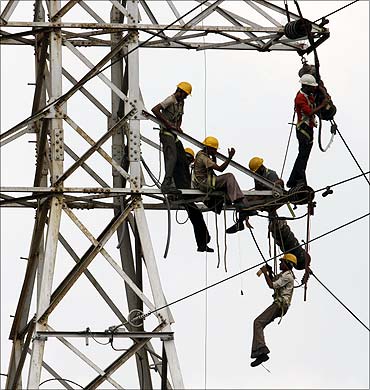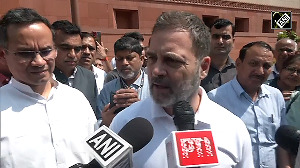
FDI can encourage a healthy flow of research and development in either direction.
Foreign direct investment (FDI) is vital to world economic growth as well as for India.
Hence, I was delighted to speak at The World Forum for FDI 2014 in Philadelphia in June. My subject, however, seemed unusual: the connection between FDI and innovation.
As I prepared, I learnt some not-so-top-of-mind nuances.
First, why FDI? For 14 years, A T Kearney has published its annual FDI Confidence Index.
The 2014 report shows that global confidence in India was ranked seven, just behind Germany and just ahead of Australia and Singapore - does not seem bad.
However, India was number two in 2012 and number five in 2013, so India has also been slipping. Knowing the political and economic events in the country, perhaps this is no surprise.
There a good prospect of a recovery in rankings in the near future.
The report argued that a core group of developing economies (China, Brazil and India) continues to enjoy widespread confidence among business leaders. Eighty per cent of respondents showed optimism about the global economy, better than the 50 and 37 per cent in the two years before.
Considering that the world FDI inflows are about $1,500 billion a year, China is impressive at $120 billion a year, but India is not so, with a much lower $25 billion annually.
All of this is a statement of opportunity for an India, where confidence is currently on an upswing.
Second, FDI is associated with a developed-market company expanding into emerging markets.
Using this perspective and using China as the example, Yufen Chen of the ZhejiangGongshangUniversity averred that FDI did not have much spillover effect on RIC or regional innovation capability, (Journal of Data Science (5), 2007).
His research manifested that increasing domestic R&D inputs, strengthening the innovation capabilities and absorptive capacities in domestic enterprises are determinants to improve the RIC.
Third, can FDI and knowledge flow from emerging markets to rich markets? India is experiencing an imperfect transformation in R&D/innovation, known to those in the field, but less than widely known.
The accomplishments of the CSIR laboratories, the space-related institutions, the agricultural universities and the IITs - all government-sponsored - are only vaguely known to the lay public.
The bright spots of these institutions are cloaked with a veil of slightly unfair, public cynicism about such institutions. Public imagination is positive when it comes to private sector and multinational (MNC) laboratories.
Currently, India has as many as 847 MNC R&D centres, representing about 83 per cent of the top 100 global R&D spenders and half of the top 500 global R&D spenders.
Patent registrations in the US from India have dramatically increased, albeit on a small base, from 94 in 2000 to 200 in 2010.
As R A Mashelkar once observed, foreign companies are using Indian brains to research their problems, develop patents for them, and then registering the patents in their own country.
Therefore, India can attract FDI on the strength of being a positive hub of innovation. This is different from what Chen described about China.
And last, three firm-level cases were presented.
Tata Toyo Radiator, a joint venture (JV) formed in 1997 with Japanese partners, was intended to absorb technology, make and sell aluminium radiators, initially to passenger car and small truck makers.
An early challenge of the JV was to interest other segments such as tractors, big commercial vehicles and diesel generating set makers to use aluminium radiators, and that too under Indian conditions.
A domestic engineering capability was established. The local engineers applied the more efficient aluminium radiator technology to replace copper brass radiators used in the non-passenger car segments. Further, auto customers sourced a part, the condenser, separately from the air-conditioning system.
The JV successfully developed the condenser locally, including the concept, the thermal design and prototyping, thus expanding the product range.
The Japanese partners were sufficiently impressed with the low-cost innovation capability of the Indian engineers.
Soon, the JV established its own research laboratory, which is filing its own patents and developing its own intellectual property rights.
Some ideas developed in the JV are influencing the Japanese partner overseas.
Reverse FDI occurred with Tata Technologies. Spun-out from the erstwhile Telco, the Pune-based company developed distinctive engineering design capabilities relevant to the Indian automotive sector.
In 2005, the company acquired a US-based company called INCAT, which had exposure to global auto companies through product design as well as product life cycle services.
In this case, the FDI involved an Indian company buying abroad. A new and eclectic mix of capabilities was nurtured, different from either the original Indian company or the acquired company.
In 2010, Tata Technologies embarked on a bold programme called eMO, standing for electric mobility.
The company debuted a fuel-efficient, environmentally-friendly, street-legal electric vehicle concept at the Detroit North American International Auto Show in 2013.
Ideas don't have border controls and visas. The third firm-level case that generated some interest was the scheme to increase boldness and experimentation in companies.
If a team makes a genuine error while doing its innovation work, as distinctive from errors due to sloppiness and not following SOPs, then the team should be applauded. Borrowing an idea from the Regensburg factory of BMW, Tata implemented a scheme called "Dare to Try" into its global operations, based on exactly this principle.
Rallis India "dared to try" to develop crystalline form of one of its herbicides, but abandoned it before commercial scale up due to the risks involved in the process.
After being recognised within Tata for its honest failure, the enthusiastic team developed an alternate process combining chemistry, equipment technology, kinetics control and catalyst usage to solve the problem.
None of these examples will be widely known in the foreseeable future.
However, they are the stuff of innovation that happens day to day in myriads of laboratories and institutions.
The fillip to innovation through cross-border openness, ideas and FDI, is an interesting feature.












 © 2025
© 2025